|

Medieval
Bath & Hygiene Display
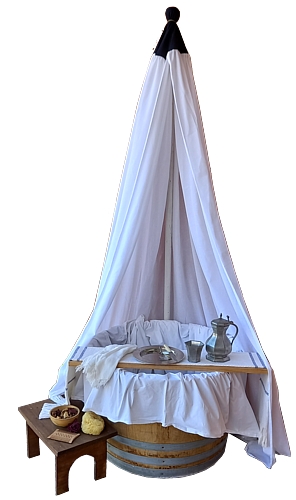
Welcome to my
newest display... a medieval bath. My fondest hope with
this display is that members of the public will come to learn
that medieval people did, in fact, bath. Many people have the
Hollywood ideal that people in the middle ages were dirty, smelly
and had poor hygiene. It just isn't true.
Soaps were known.
Food and drink might be taken in the tub while a musician provided
entertainment.
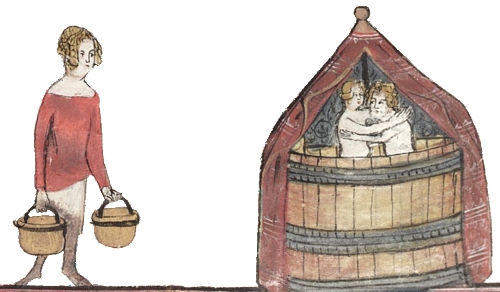
In the 14th century Boccaccio's
the Decameron we read about bathing-
Without permitting
anyone else to lay a hand on him, the lady herself washed
Salabaetto all over with soap scented with musk and cloves.
She then had herself washed and rubbed down by the slaves.
This done, the slaves brought two fine and very white sheets,
so scented with roses that they seemed like roses; the slaves
wrapped Salabaetto in one and the lady in the other and then
carried them both on their shoulders to the bed.
They then took from the basket silver vases of great beauty,
some of which were filled with rose water, some with orange
water, some with jasmine water, and some with lemon water,
which they sprinkled upon them. After which they refreshed
themselves with boxes of sweetmeats and the finest wines.
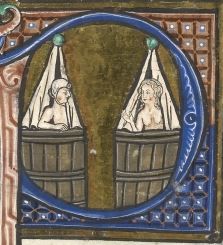 The
image at left is my base style guide and is from Sloane 2435,
Aldobrandino of Siena, Le Régime du corps (ff. 1-75v);
Image du monde (ff. 77-133v) France, N. Dated to the 3rd
quarter of the 13th century (perhaps c. 1285) Folio 8v. My aim
is to provide the trappings of a bath house in a domestic setting.
Herbs for bathing, soaps, a tub and board with food and drinks,
a striped linen towel and some personal grooming tools and skin
care. The
image at left is my base style guide and is from Sloane 2435,
Aldobrandino of Siena, Le Régime du corps (ff. 1-75v);
Image du monde (ff. 77-133v) France, N. Dated to the 3rd
quarter of the 13th century (perhaps c. 1285) Folio 8v. My aim
is to provide the trappings of a bath house in a domestic setting.
Herbs for bathing, soaps, a tub and board with food and drinks,
a striped linen towel and some personal grooming tools and skin
care.
The Tacuinum sanitatis of Liege, folio 76, writes of the
virtues of bathing with Water of A Pleasurable Warmth:
Nature: Warm and humid
in the second degree.
Optimum: The kind that opens the pores with moderate heat
or with a fever.
Usefulness: For bodies with open pores; furthermore, it lowers
the temperature.
Dangers:
for intestinal flow.
Neutralisation of the dangers: With astringent drinks.
Drinks, therefore, were recommended.
Bathhouses also got a pretty bad reputation as houses of ill-repute,
and with just cause at times. The Paris Bathhouse Keepers Guild
had strict rules to follow. These included rules for those running
and attending the baths.
These included:
Whoever wishes to
be a bathhouse-keeper in the city of Paris may freely do so,
provided he works according to the usage and customs of the
trade, made by agreement of the commune, as follow.
No man or woman may
heat up their baths on Sunday, or on a feast day which the
commune of the city keeps.
And every person
should pay, for a steam-bath, two deniers; and if he bathes,
he should pay four deniers.
And because at some
times wood and coal are more expensive than at others, if
anyone suffers, a suitable price shall be set by the provost
of Paris, through the discussion of the good people of the
aforesaid trade, according to the situation of the times.
No man or woman of
the aforesaid trade may maintain in their houses or baths
either prostitutes of the day or night, or lepers, or vagabonds,
or other infamous people of the night.
As for where a woman might
acquire items for her personal toilette, she might just buy them
from a shop or be given them, as a lover's gift.
Andreas Capellanus, a 12th
century author of De Amore gives an insight into what dress
accessories were available and could be given as a gift of love-
"A lover may
freely accept from her beloved these things- a handkerchief,
a hairband, a circlet of gold or silver, a brooch for the
breast, a mirror, a belt, a purse, a lace for clothes,
a comb, cuffs, gloves, a ring, a little box of scent,
a portrait, toiletries, little vases, trays, a standard
as a keepsake of the lover, and so to speak more generally,
a woman may accept from her love whatever gift may be useful
in the care of her person, or may look charming, or may
remind her of her lover, providing, however, that in accepting
the gift it is clear that she is acting quite without avarice."
A 13th century French song
described in Love Lock'd Out, A Survey of Love, Licence and
Restriction in the Middle Ages by James Cleugh refers to a
peddlar who carries for sale:
'razors, tweezers,
looking glasses, toothbrushes and tooth-picks,
bandaus and curling irons, ribbons, combs, mirrors,
rosewater... cotton with which they rouge
themselves and whitening with which they whiten themselves.'
showing the large range of
grooming cosmetics and tools which were in use and available at
the time.

Below are listed
the individual pieces for my bath house display and their sources
and contruction methods if known. The display also includes a
talk on basic medieval hygiene and skin care and includes samples
of some medieval skin care products.
|
Infrastructure
|
 Bath
tub Bath
tub
Country of Origin:
generic
Time Period: medieval
Type of Item: bath
Colour/colours: natural
Materials: Oak, metal
Construction: traditionally made wine cask half with
securing metal bands
Decoration & Finshes: painted interior. Iron
bands to be covered with flexible wood. wip
Documentation: The Hague, KB, 76 F 21 fol. 15r Mary
in bath Fol. 15r
|
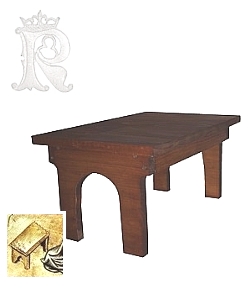 Wooden
Low Stool Wooden
Low Stool
Country of Origin: Generic
Time Period: medieval
Type of Item: Stool
Colour/colours: Oak stain
Materials: Pine
Construction: Nailed and glued
Decoration & Finshes: 2 coats of stain, Curved
end pieces.
Made by: Rosalie's Medieval Woman
Documentation: Elizabeth Altarpiece from the Church
of St. Agidius at Bardejov, c. 1480-1500 |
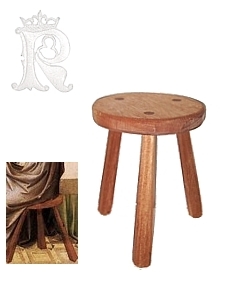 Three
legged stool Three
legged stool
Country of Origin: England
Time Period: 14th century
Type of Item: Stool
Colour/colours: natural
Materials: maple
Construction: Traditional methods recycling a 1950s
church pew
Decoration & Finshes: Waxed with beeswax &
olive oil
Made by: Roy Davi, The Leura Bodger, Blue Mountains.
|
|
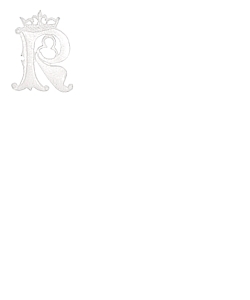 Board Board
Country of Origin:
Generic
Time Period: medieval
Type of Item: bath board
Colour/colours: Oak stain
Materials: Pine
Construction: cut to size
Decoration & Finshes: none
Made by: Rosalie's Medieval Woman
Documentation: Medieval art
|
|
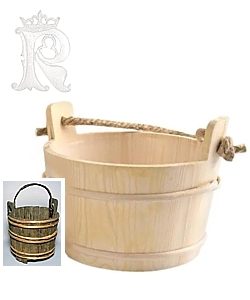 Wooden
bucket Wooden
bucket
Country of Origin:
Generic
Time Period: Medieval
Type of Item: Wooden bucket
Colour/colours: Brown
Materials: Wood
Construction: unknown
Made by:
Documentation: Codices vindobonenses 2759-2764 in
the Osterreichischen Nationalbibliothek, in Vienna, Austria.
|
|
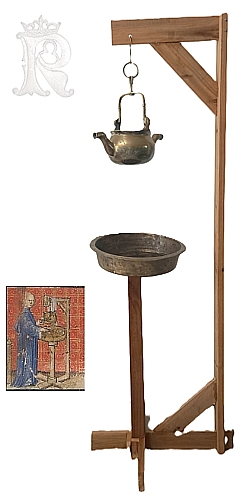 Lavabo
stand Lavabo
stand
Country of Origin:
Multiple generic
Time Period: medieval- 14th and 15 centuries
Type of Item: lavabo stand
Colour: natural
Materials: pine
Decoration: none
Construction: Hand made, glued and nailed with interlocking
pieces to enable transporting
Made by: Rosalie Gilbert
Documentation: 14th century, Roman de la Rose (multiple
versions)
|
|
bathing things
|
|
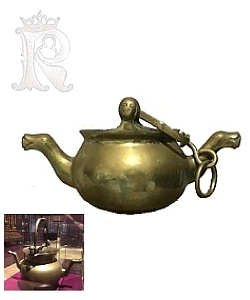 Lavabo
for stand Lavabo
for stand
Country of Origin:
Time Period: medieval
Type of Item: Lavabo
Colour: brass
Materials: brass
Decoration: animal heads with women's faces on the
handles
Construction: 19th century reproduction. Hand made.
Made by: unknown
Documentation: 14th century, Roman de la Rose (multiple
versions), artifact 1451 Historisches Museum, Frankfurt
|
|
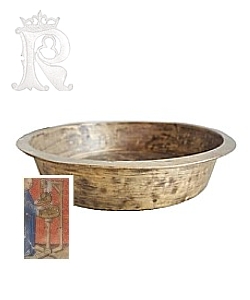 Bronze
dish for Lavarbo Bronze
dish for Lavarbo
Country of Origin:
Time Period: medieval
Type of Item:
Colour:
Materials: bronze
Decoration:
Construction: Hand made, wide, flat lip.
Made by: Vintage item from Comfort Room, Ukraine
Documentation: 14th century, Roman de la Rose (multiple
versions)
|
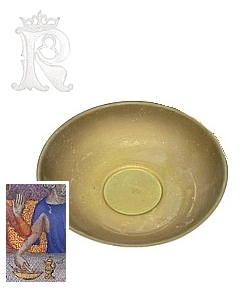
Brass
dish for hand washing
Country of Origin:
Time Period: medieval
Type of Item: dish
Colour:
Materials: brass
Decoration: small turned lip
Construction: Commercially made
Made by:
Documentation: 14th century
|
|
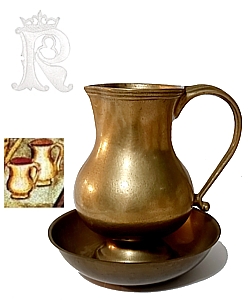 Brass
jug and bowl Brass
jug and bowl
Country of
Origin: France/England
Time Period: medieval
Type of Item: small jug and bowl for sponge bathing
Colour: brass
Materials: brass
Decoration: none
Construction: Hand made
Made by:
Documentation: 14th century manuscript, Tacuinim
sanitatus.
|
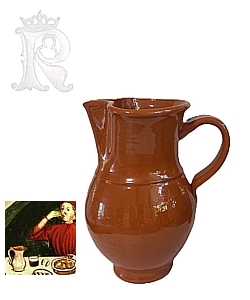 Water
jug Water
jug
Country of Origin: Generic
Time Period: medieval
Type of item: ceramic water jug
Colour: terracotta
Materials: clay
Decoration: glazed
Made by: unknown
Documentation: extant finds
|
cosmetics & consumables
soap
|
|
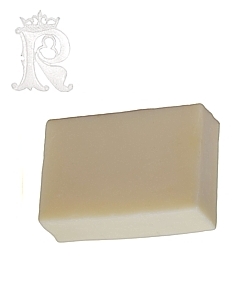 Castile
Soap 110g Castile
Soap 110g
Country of Origin:
Castile
Time Period: medieval
Type of item: unscented soap
Colour: natural
Materials: Saponified olive oil, Alden's Olives,
Cohuna, Victoria.
Decoration: none
Made by: Biome, Brisbane
Documentation: written accounts.
Gilbertus Anglicus writes about the various types of soap
in the 14th century and lists Castile soap.
One written reference to scented soaps, comes from 14th
century Boccaccio's the Decameron where we read-
"...the
lady herself washed Salabaetto all over with soap scented
with musk and cloves..."
Whether or not this
scented soap was the luxurious Castille soap is not mentioned.
|
|
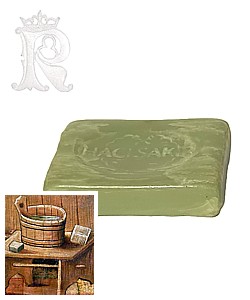 Aleppo
Soap Aleppo
Soap
Country of Origin:
Time Period: medieval
Type of item: unscented soap
Colour: natural
Materials:
Decoration: none
Made by:
Bought from:
Documentation: written accounts
Gilbertus Anglicus writes about the various types of soap
in the 14th century
|
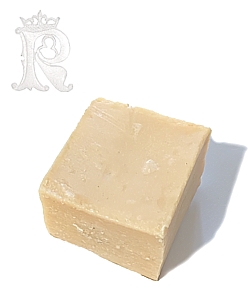
Nablus
Soap
Country of Origin:
Time Period: medieval
Type of item: Soap
Colour: natural
Ingredients: 100% Extra Virgin Olive Oil, water and
caustic soda..
Decoration: none
Made by: Nablus Soap Company. EcoCert, Palestine.
Bought from: Mainly Medieval
Documentation: written accounts
Gilbertus Anglicus writes about the various types
of soap in the 14th century.
Mainly Medieval: Nablus soap is classified as one
of the original Castille soaps and was known to be traded
into the Western Medieval markets through a number of trade
channels. It has been in production for thousands of years
in areas such as Syria and there are still family businesses
continuing to make this olive oil soap in the traditional
manner to this day.
The difference between
the Aleppo and Nablus is simply that after the Aleppo soap
has been aged, it is then shredded and re-processed again,
creating a much finer textured and paler coloured soap.
The Nablus has always been more expensive due to the further
production steps and storage times to allow the soap to
harden to the corrent consistancy. As such it has also been
generally used for the export market, as its appearance
was deemed more in keeping with the Western perceptions.
|
|
 Venetian
Barber Soap Venetian
Barber Soap
Country of Origin:
Time Period: medieval
Type of item: Soap
Colour: natural
Materials:
Decoration: none
Made by: Roxy
Macdonald
Bought from: Mainly Medieval
Documentation: written accounts
Gilbertus Anglicus writes about the various types of soap
in the 14th century
|
|
 Rosewater
for handwashing Rosewater
for handwashing
Country of Origin: Everywhere
Time Period: medieval
Type of Item: rosewater
Colour: pale pink
Materials: roses
Decoration: n/a
Made by: Besttaste, Iran
Documentation: Trotula et al
|
|
 Hand
washing water Hand
washing water
Country of Origin:
France
Time Period: 14th century
Type of Item: herbal waters
Colour:
Materials:
Decoration: n/a
Made by: Rosalie's Medieval Woman
Documentation: Le Mesnagier de Paris. From A Medieval
Home Companion: Housekeeping in the 14th century, Tania
Bayard, from the Goodman of Paris
"To make
water for washing hands at table: Boil sage, then strain
the water and cool until it is a little more than lukewarm.
Or use chamomile, marjoram or rosemary boiled with orange
peel. Bay leaves are also good."
|
cosmetics & consumables
for hair
|
|
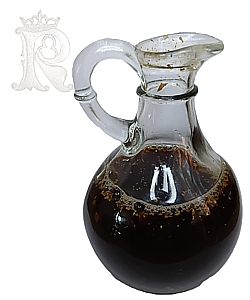 Rosewater
with hairpowder Rosewater
with hairpowder
the Trotula Texts
Country
of Origin: Salerno
Time Period: medieval
Type of Accessory: hair powder
Colour: natural
Materials: dried roses, clove, nutmeg, watercress,
galangal, rose water
Made by: Rosalie's Medieval Woman
Documentation: Trotula, On Cosmetics (attributed)
The Trotula,
or the set of three texts attributed to Trotula, include
On Women's Cosmetics, and include recipes for beauty
including a beautiful-smelling hair powder, so that the
hair remains sweetly scented. In the section about On
Various Kinds of Adornments, it reads:
But when she combs
her hair, let her have this powder. Take some dried roses,
clove, nutmeg, watercress and galangal. Let all these,
powdered, be mixed with rose water. With this water let
her sprinkle her hair and comb it with a comb dipped in
this same water so that [her hair] will smell better.
And let her make furrows in her hair and sprinkle on the
above-mentioned powder, and it will smell marvelously.
The entire process
of living history experiment recreating the hair powder
according to the recipe, is here on the TROTULA'S
HAIR POWDER page.
|
|
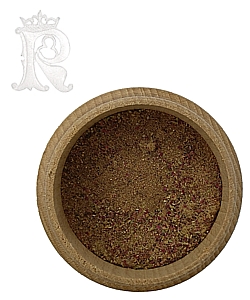 Hair
powder Hair
powder
the Trotula Texts
Country of Origin: Salerno
Time Period: medieval
Type of Accessory: hair powder
Colour: natural
Materials: dried roses, clove, nutmeg, watercress,
galangal, rose water
Made by: Rosalie's Medieval Woman
Documentation: the Trotula texts, On Cosmetics
(attributed)
The Trotula,
or the set of three texts attributed to Trotula, include
On Women's Cosmetics, and include recipes for beauty
including a beautiful-smelling hair powder, so that the
hair remains sweetly scented. In the section about On
Various Kinds of Adornments, it reads:
But when she combs
her hair, let her have this powder. Take some dried roses,
clove, nutmeg, watercress and galangal. Let all these,
powdered, be mixed with rose water. With this water let
her sprinkle her hair and comb it with a comb dipped in
this same water so that [her hair] will smell better.
And let her make furrows in her hair and sprinkle on the
above-mentioned powder, and it will smell marvelously.
The entire process
of living history experiment recreating the hair powder
according to the recipe, is here on the TROTULA'S
HAIR POWDER page.
|
cosmetics & consumables
for teeth
|
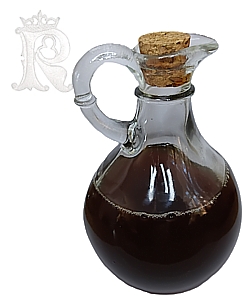
Mouthwash
Hildegarde von Bingen's Sage & wine
Country of Origin:
Salerno
Time Period: medieval
Type of Item: mouthwash and breath freshener.
Colour:
Ingredients: Sage, white wine
Made by: Rosalie Gilbert
documentation: Hildegard von Bingen's book Physica deals
with the properties of things; animals, stones, minerals,
plants and elements of the earth. She looks at what these
things may be good for and offers remedies for health concerns.
One of these is dealing with bad breath. It reads:
"Anyone...
who has stinking breath, should cook sage in wine, strain
it through a cloth, and drink it often."
|
|
 Mouthwash Mouthwash
Bancke's mint & vinegar
Country of Origin:
England
Time Period: medieval
Type of Item: breath freshener
Colour: green
Materials: vinegar, mint
Made by: Rosalie's Medieval Woman
Documentation: Bankes' Herbal, 1525. From Bankes'
Herbal, 1525
"For the
stinking of the mouth and filth of the gums and of the
teeth, wash thy mouth and gums with vinegar that mints
have been sodden in; after that, rub them with the powder
of mints or with dry mints."
|
|
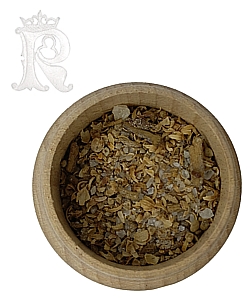 Tooth
Powder Tooth
Powder
the Trotula texts
Country of Origin:
Salerno
Time Period: medieval
Type of Accessory: tooth powder
Colour: natural
Materials: cinnamon, clove, spikenard, mastic, frankincense,
grain, wormwood
Made by: Michelle Barton, Cabinet of Medieval Curiousity
Documentation: Trotula, On Cosmetics (attributed)
The Trotula, or the
set of three texts attributed to Trotula, include On
Women's Cosmetics, and include recipes for beauty including
tooth powder. She writes:
Take some each
of cinnamon, clove, spikenard, mastic, frankincense,
grain, wormwood, crab foot, date pits, and olives. Grind
all of these and reduce them to a powder, then rub the
affected places. Your breath, with its mix of frankincense
and crab foot, will let everyone know just how wealthy
you are.
Notes: This
recipe was made without olives and date pits and crabfoot,
which is an ingrediant of unsure type. Plant? Animal?
There is a Chinese tea called Crabfoot, which may be the
ingrediant, or not, depending on whether it was known
at this time. The inclusion of frankincense may hint at
exotic imports, but it also really may not. There is a
plant which also might be it, but it's not a perfect match
either.
|
|
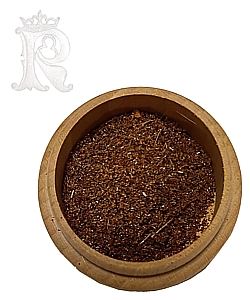 Tooth
Powder Tooth
Powder
the Trotula texts
Country of Origin:
Salerno
Time Period: medieval
Type of Accessory: tooth powder
Colour: natural
Materials: cinnamon, clove, spikenard, mastic, frankincense,
grain, wormwood, date pits and olives.
Made by: Rosalie Gilbert, Rosalie's Medieval Woman
Documentation: Trotula, On Cosmetics (attributed)
The Trotula, or the
set of three texts attributed to Trotula, include On
Women's Cosmetics, and include recipes for beauty including
tooth powder. She writes:
Take some each
of cinnamon, clove, spikenard, mastic, frankincense,
grain, wormwood, crab foot, date pits, and olives. Grind
all of these and reduce them to a powder, then rub the
affected places. Your breath, with its mix of frankincense
and crab foot, will let everyone know just how wealthy
you are.
Notes: This
recipe was made without crabfoot, which is an ingrediant
of unsure type. Plant? Animal? There is a Chinese tea called
Crabfoot, which may be the ingrediant, or not, depending
on whether it was known at this time. The inclusion of frankincense
may hint at exotic imports, but it also really may not.
There is a plant which also might be it, but it's not a
perfect match either.
|
|
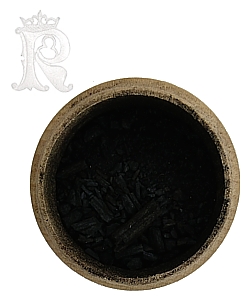 Tooth
powder 2 Tooth
powder 2
Branke's Rosemary Charcoal
Country of Origin:
England
Time Period: medieval
Type of Item: tooth powder
Colour: black
Materials: rosemary
Made by: Rosalie's Medieval Woman
Documentation: Bankes' Herbal, 1525 [English]Another
charcoal tooth powder recipe comes from Bankes' Herbal,
dated 1525.
"Also take
the timber thereof [rosemary] and burn it to coals and
make powder thereof and put it into a linen cloth and
rub thy teeth therewith, and if there be any worms therein,
it shall slay them and keep thy teeth from all evils."
|
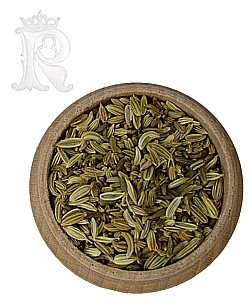 Breath
Freshener Breath
Freshener
Fennel seed
Country of Origin:
Time Period: medieval
Type of Item: breath freshener
Colour: natural
Materials: fennel seed
Made by: Rosalie's Medieval Woman
Documentation: Trotula, On Cosmetics.
Trotula, On Cosmetics.
For breath-freshening, Trotula, or the set of three
texts attributed to Trotula, include On Women's Cosmetics,
include recipes for keeping the breath fresh. She writes:
:
"The woman
should wash her mouth after dinner with very good wine.
Then she ought to dry very well and wipe with a new white
cloth.
Finally, let her chew each day fennel or lovage
or parsley, which is better to chew because
it gives off a good smell and cleans good gums and makes
the teeth very white."
|
|
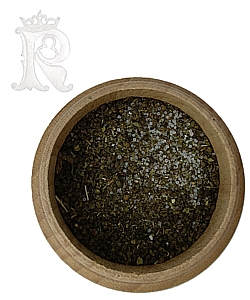 Breath
freshener 2 Breath
freshener 2
Gilbertus Anglicus
Country of Origin:
England
Time Period: medieval
Type of Item: breath freshener
Colour: natural
Materials: pepper, mint, salt
Made by: Rosalie's Medieval Woman
Documentation: Gilbertus Anglicus, about 1400, English
For breath-freshening,
Gilbertus Anglicus, about 1400, English
"And let
him use this powder: Take of pepper, one ounce; and of
mint, as much; and of rock salt, as much. And make him
to chew this powder a good while in his mouth, and then
swallow it down."
|
|
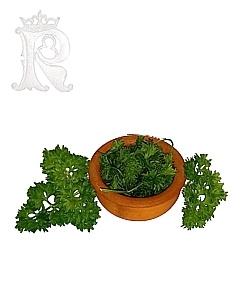 Breath
freshener Breath
freshener
Trotula parsley
Country of Origin:
Time Period: medieval
Type of Item: breath freshener
Colour: green
Materials: parsley
Made by: Rosalie's Medieval Woman
Documentation: Trotula, On Cosmetics. For
breath-freshening, Trotula, or the set of three texts attributed
to Trotula, include On Women's Cosmetics, include
recipes for keeping the breath fresh. She writes: :
"The woman
should wash her mouth after dinner with very good wine.
Then she ought to dry very well and wipe with a new white
cloth.
Finally, let her chew each day fennel or lovage or parsley,
which is better to chew because it gives off a good smell
and cleans good gums and makes the teeth very white."
|
cosmetics & consumables
skin care etc
|
|
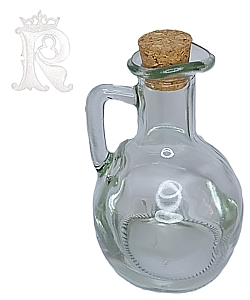 Perfume-
Queen of Hungary Water Perfume-
Queen of Hungary Water
Country
of Origin:
Time Period: medieval
Type of Accessory: Perfume
Colour: Clear
Construction Materials: Alcohol, rosemary, lemon,
frankinsence, rose and neroli essential oils.
Made by: Roxy, Medieval Still Room.
Bought from: Mainly Medieval, Sydney.
documentation:
|
|
 Rouge Rouge
Country of Origin:
France
Time Period: 13th century
Type of Item: rouge for pink cheeks
Colour: pink
Materials: dyed red wool
Made by: Rosalie's Medieval Woman
Documentation: Love
Lock'd Out, A Survey of Love, Licence and Restriction in
the Middle Ages by James Cleugh. A
13th century French song refers to a peddlar who carries
for sale:
'razors, tweezers,
looking glasses, toothbrushes and tooth-picks, bandaus
and curling irons, ribbons, combs, mirrors, rosewater...
cotton with which they rouge themselves
and whitening with which they whiten themselves.'
|
|
 Foundation Foundation
Country of Origin:
France
Time Period: 13th century
Type of Item: lip balm
Colour:
Materials:
Made by: Rosalie's Medieval Woman
Documentation: L'ornement des Dames The
L'Ornement des Dames gives this recipe for making an easy
foundation:
There is a white
make-up that is very easy to make. Put very pure wheat
in water for fifteen days, then grind and blend it in
the water. Strain through a cloth, and let it crystalise
and evaporate. You will obtain a make-up which will be
as white as snow. When you want to use it, mix it with
rosewater, and spread it on your face which has first
been washed with warm water. Then dry your face with a
cloth.
|
|
 Lip
balm/stain Lip
balm/stain
Country of Origin:
Time Period: medieval
Type of Item: lip balm
Colour:
Materials:
Made by: Rosalie's Medieval Woman
Documentation: Trotula, On Cosmetics. Also Secrets
of Don Alessio Piemontese.
One recipe for a medieval lip balm described as a 'sweet
smelling grease that will keep the lips and hands from chapping
and make them moist and soft' comes from the book Secrets
of Don Alessio Piemontese, published in 1557.
'Take 12 oz of
fresh suet and 6oz of marjoram and pound them together.
Form into balls and sprinkle with good wine. Next put
into some vessel and seal it tightly so that the odor
of the marjoram does not escape. Place in the shade for
24 hours and then put into water. Cook slowly, then strain.
This process must be repeated 4 or 5 times always adding
another 9oz of suet. Finally a little musk or civet can
be added.'
|
|
 Skin
tonic Skin
tonic
Country of Origin:
Time Period: medieval
Type of Item: Tonic to...
Colour:
Materials:
Made by: Rosalie's Medieval Woman
Documentation: The Old Woman from the manuscript
the Roman de la Rose also offers advice on skincare:
If her complexion
loses colour and her heart is tormented as a result, she
should arrange always to have aqueous ointments hidden
in boxes in her chamber, for the purpose of painting her
face. But she must take care that none of her guests can
smell or see them: otherwise she could be in great trouble...
If her hands are not fair and unblemished but marred by
spots and pimples, she ought not to leave these alone
but use a needle to remove them; or else she should hide
her hand in her gloves so that the spots and scabs are
not visible.
|
|
 Fresh
herbs for bathing Fresh
herbs for bathing
Country of Origin:
Time Period: medieval
Type of Item:
Colour:
Materials:
Made by: Rosalie's Medieval Woman
Documentation: Many sources indicate that scented and
herbal bathwaters were enjoyed in the medieval period. In
the 14th century Boccaccio's the Decameron we read
about bathing-
Without permitting
anyone else to lay a hand on him, the lady herself washed
Salabaetto all over with soap scented with musk and cloves.
She then had herself washed and rubbed down by the slaves.
This done, the slaves brought two fine and very white
sheets, so scented with roses that they seemed like roses;
the slaves wrapped Salabaetto in one and the lady in the
other and then carried them both on their shoulders to
the bed.
They then took
from the basket silver vases of great beauty, some of
which were filled with rose water, some with orange water,
some with jasmine water, and some with lemon water, which
they sprinkled upon them. After which they refreshed themselves
with boxes of sweetmeats and the finest wines.
|
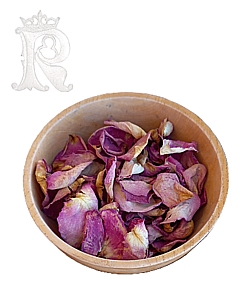 Rose
petals Rose
petals
Country of Origin: Everywhere
Time Period: medieval
Type of Item: rose petals for bathwater and handwashing
Colour: red, pink
Materials: roses
Made by: Rosalie's Medieval Woman
Documentation: bathtub scene, Manesse Codex, mentions
in health handbooks.
|
|
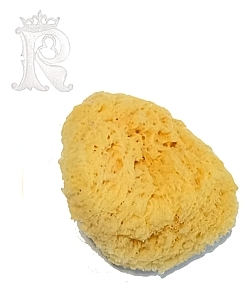 Sea
Sponge: large 17cm Sea
Sponge: large 17cm
Country of Origin: Italy
Time Period: medieval
Type of item: Sea sponge
Outer Colour: natural
Materials: none
Decoration: none
Made by: nature
Documentation: Bath scene
|

Sponges
x 4
Country of Origin:
England
Time Period: 14th century
Type of Accessory: Sponges
Outer Colour: natural
Construction Materials: sea sponges
Details of Decoration: none
Made by:
Bought from: Priceline, Rochedale South
documentation
|
|
personal items
|
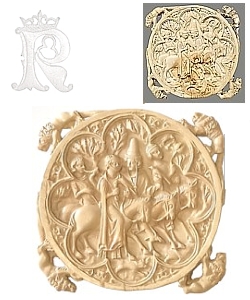 Ivory
mirror case Ivory
mirror case
Country of Origin: France
Time Period: 14th century.
Type of Accessory: Mirror
Materials: Resin, glass
Construction: Cast resin mirrorcase with glass foil-backed
mirror. Hand cast.
Decoration: Hunting scene with four lions.
Dimensions: 110mm diameter.
Made by: (? Poland?Checz)
Documentation: Extant mirror, Louvre
|
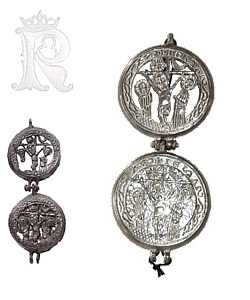 Pewter
folding mirror case Pewter
folding mirror case
Country
of Origin: England
Time Period: pre 1350.
Type of Accessory: Mirror
Construction Materials: Metal, glass
Metal: Pewter
Details of Construction: Pin hinged mirrorcase with
glass foil-backed mirror. Hand cast.
Details of Decoration: The crucifixion scene shows
Saint John with a bible to the left and Mary carrying a
purse to the right. Above the figure of Christ is a sun
and moon.
Dimensions: 50mm diameter.
Made by: Steve Millingham's Pewter Replicas, England
Documentation: Museum of London collection. Original
made of lead-tin alloy
|
|
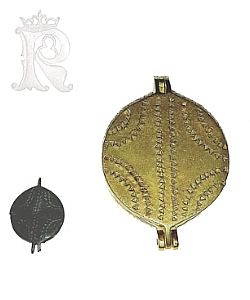 Brass-bronze
folding mirror case Brass-bronze
folding mirror case
Country of Origin:
England
Time Period: 14th century
Type of Accessory: Mirror
Construction Materials: Metal, glass
Metal: Brass
Details of Construction: Pin hinged mirrorcase with
glass foil-backed mirror. Hand made with rocker wriggle
work on the case exterior.
Details of Decoration:
Dimensions: mm diameter.
Made by: Daniel Woldenberg.
Bought from: Zeitenhandel, Germany.
Documentation: Gilbert Collection. PAS database.
|
|
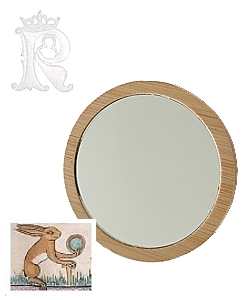 Wooden
mirror case Wooden
mirror case
Country
of Origin: Generic
Time Period: 14th century.
Type of Accessory: Mirror
Construction Materials: wood, glass
Metal: none
Details of Construction: wooden mirror case with
glass mirror
Details of Decoration: none
Dimensions: mm diameter.
Made by:
Bought from: Temu
Documentation: Manuscripts 13-15th centuries
|

Wooden
mirror case
Country of Origin:
Time Period: 14th century.
Type of Accessory: Mirror
Construction Materials: wood, glass
Metal: none
Details of Construction: wooden mirror case with
glass mirror
Details of Decoration: painted
Dimensions: mm diameter.
Made by: painted by Rosalie
Bought from: Temu
Documentation: Manuscripts 14th centuries, including
Luttrell Psalter
|
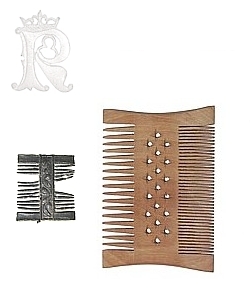 Wooden
double sided comb Wooden
double sided comb
Country of Origin: England, France
Time Period: 14th century
Type of item: Double sided comb
Colour: natural wood
Materials: Wood, type unknown (boxwood?)
Construction: Hand made
Decoration: Series of decorative stars on comb body
Made by: unknown
Documentation: 14th century Paris comb, Elizabeth Altarpiece
from the Church of St. Agidius at Bardejov, c. 1480-1500
Documentation: 15th century French boxwood comb in
the private collection of Mrs Leopold Blumka. |
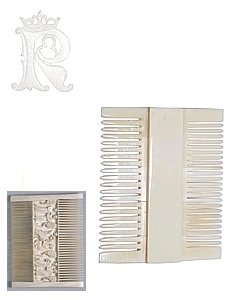 Bone double sided comb
Bone double sided comb
Country of Origin:
England, France
Time Period: 14th century
Type of Accessory: Double sided comb
Outer Colour: creamy white
Construction Materials: bone
Details of Construction: Hand made reproduction of
generic medieval comb
Details of Decoration: undecorated
Made by: ?
Bought from: Make Your Own Medieval, Brisbane
Documentation: 14th century Paris comb
|
|
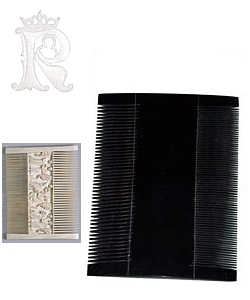 Horn
double sided comb Horn
double sided comb
Country of Origin:
England, France
Time Period: 14th century
Type of Accessory: Double sided comb
Outer Colour: black/brown
Construction Materials: horn
Details of Construction: Hand made reproduction of
generic medieval comb
Details of Decoration: undecorated
Made by:
Documentation: 14th century Paris ivory comb
|
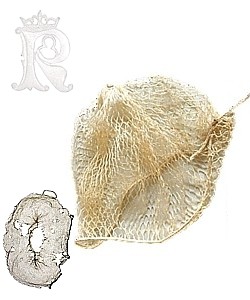 Silk
hair net Silk
hair net
Country of Garment: England & Europe
Time Period: 12-15th century
Type of Garment: hair net
Outer Colour: cream
Outer Fabric: silk
Decorative features: No decorative features
Construction method: Hand netted using traditional
methods
Bought from: Knots In A Net
Made by: Knots In A Net
Documentation:
Museum of London original |
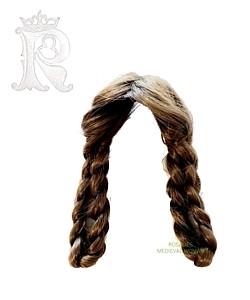 Braided
Hair Braided
Hair
Country of Garment:
England/Europe
Time Period: 13-14th century
Type of Garment: False hair
Outer Colour: Dark brown
Outer Fabric: False hair
Decorative features: no decoration or embroidery.
Construction method: Braided hair styled and stitched
with brown quilting thread.
Bought from: False hair purchased from Op Shop
Made by: Rosalie
Documentation There is written and pictorial evidence of women
wesaring false hair, which was regarded as sinful. The prime
reasons are if one was using real hair, it may have come from
a prostitute or sick woman and the hair might pass there attributes
to the wearer. Alternately, choosing to have hair other than
the kind that God gave you was sinful, vain and seen as wanting
more than you were blessed with. |
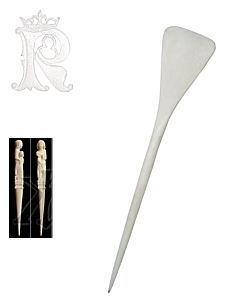 Bone
Gravoire (hair parter) Bone
Gravoire (hair parter)
Country of Origin: France
Time Period: 14th century
Type of item: Hair parter- gravoire
Colour: White
Materials: Bone
Construction: Hand carved and shaped
Decoration: undecorated
Made by: unknown
Documentation: (not the one shown) 14th century Italy,
Ivory. Collection of Mrs Ernest Brummer
|
|
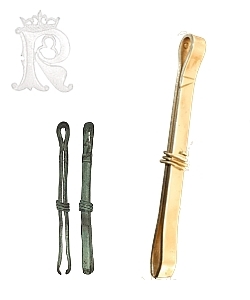 Tweezers Tweezers
Country of Origin:
England
Time Period: medieval
Type of Item: locking tweezers
Colour: gold
Materials: brass
Decoration: several incised grooves, locking wire
Construction: Hand made
Made by: Gaukler Medieval Wares
Documentation: 14th century artifact, The Gilbert Collection
|
|
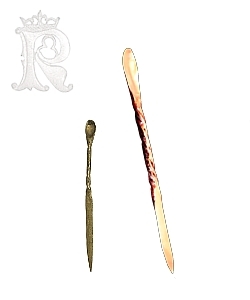 Earscoop
& nail cleaner Earscoop
& nail cleaner
Country of Origin:
Time Period: medieval
Type of Item: ear scoop and nail cleaner
Colour: gold
Materials: brass
Decoration: barley twist main stem
Construction: Hand made
Made by: Gaukler Medieval Wares
Documentation: 14th century artifact, The Gilbert Collection
|
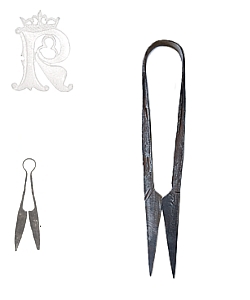
Hair
trimming scissors
Country of Origin:
Europe & England
Time Period: 14th century
Type of Item: Scissors
Outer Colour/colours: black
Construction Materials: Iron
Details of Construction: cm. Handforged.
Details of Decoration & Finishes: none
Imported by: Medieval Design, Italy
|
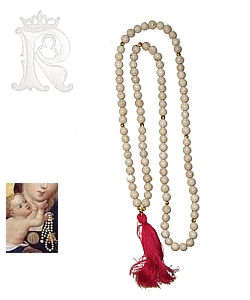 Paternoster Paternoster
Country of Origin: England
Time Period: 14th century
Type of Item: Paternoster
Colour/colours: red, white, gold
Materials: Linen thread, marble, gold spacers, red
silk tassel
Construction: Ten groups of ten beads threaded onto
linen, gold spacer, with tassel terminating at the end.
Decoration: none
Made by: Rosalie's Medieval Woman
Documentation: 1400s Mother of God With Pea Blossom,
Master of Cologne, Germany
|
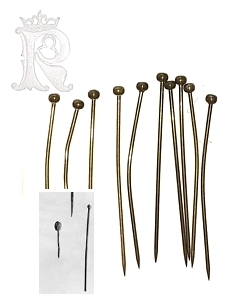 Ball
headed dress pins Ball
headed dress pins
Country of Origin: Generic
Time Period: 14th century
Type of Item: veil pins
Colour: gold
Materials: brass
Construction: hand made
Decoration: ball heads
Made by: Bero Heftelmacher, Bero von Saeckingen, Germany
Documentation: Extant pins, Museum of London
|
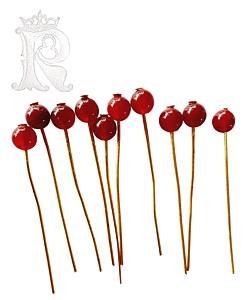
Carnelian
headed dress pins - red
Country of Origin:
Generic
Time Period: 14th century
Type of Accessory: veil pins
Outer Colour: brass,
Construction Materials: brass, carnelian
Details of Construction: hand made
Details of Decoration: carnelian bead heads
Made by: Commercial pins, Rosalie beaded
Bought from: Spotlight (pins), carnelian: Beads N
Things, Stones Corner
Documentation: contemporary art
|
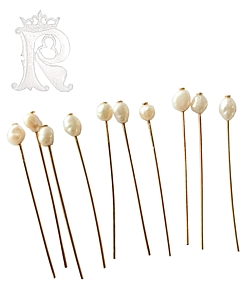
Pearl
headed dress pins
Country of Origin:
Generic
Time Period: 14th century
Type of Accessory: veil pins
Outer Colour: brass, cream
Construction Materials: brass, freshwater pearls
Details of Construction: hand made
Details of Decoration: pearl bead heads
Made by: Commercial pins, Rosalie beaded
Bought from: Spotlight (pins), pearls: Beads N Things,
Stones Corner
Documentation: contemporary art
|
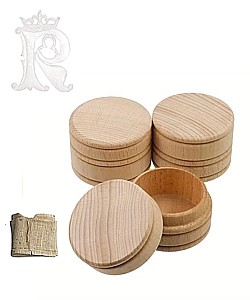 Cosmetics
containers Cosmetics
containers
Country of Origin: Generic
Time Period: Medieval
Type of Item: Container
Colour/colours: Natural
Materials: Beech wood
Construction: Hand turned
Decoration & Finishes: 3 grooves
Made by: Lockzhiner, China
Bought from: Temu
Documentation: Artifacts
|
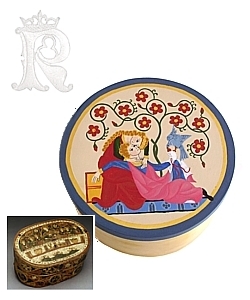 Birch
Box with lid Birch
Box with lid
Country of Origin:
Time Period: 14th century
Type of Item: Bentwood box
Colour/colours: Light brown
Materials: Birch
Construction: Commercially produced
Dimensions: 19cm diameter
Decoration & Finishes: handpainted with scene from
the Manesse Codex, Germany
Made by: unknown, painted by Rosalie's Medieval Woman
Documentation: Extant painted box
|
|
Soft furnishings & Linens
|
|
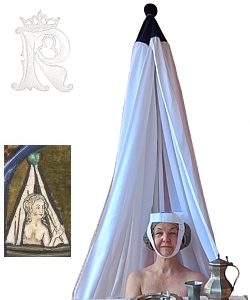 Bath
curtains Bath
curtains
Country of Origin:
England
Time Period: medieval
Type of Item: curtains
Colour/colours: white
Materials: linen
Construction: machined stitching
Decoration & Finishes: navy blue circular top
Made by: Rosalie's Medieval Woman
Documentation: Aldobrandino of Siena, Le Régime
du corps folio 8v
|
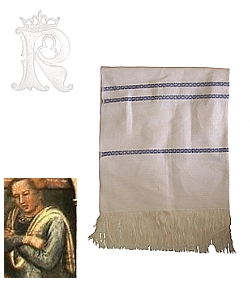 Striped
Towel Striped
Towel
Country of Origin: Everywhere
Time Period: 13th-15th century
Type of Item: Towel
Colour/colours: Blue and white
Materials: Flax linen/cotton
Construction: Hand woven
Dimensions: 35cm x 150cm
Decorations: diamond weave with blue stripes and tassels
Made by: unknown for Medieval Design, Italy
Documentation: 1350 Manuscript Naples Wedding at Canna
|
|
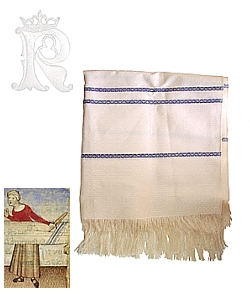 Striped
Tablecloth Striped
Tablecloth
Country of Origin: Everywhere
Time Period: 13th-15th century
Type of Item: Towel
Outer Colour/colours: Blue and white
Construction Materials: Flax linen/cotton
Construction: Hand woven
Dimensions: cm x cm
Decorations: diamond weave with blue stripes and
tassels
Made by: unknown for Medieval Design, Italy
Documentation:
|
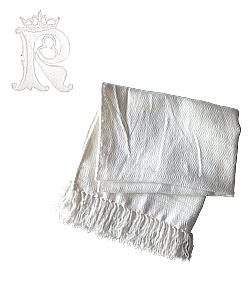 Hand
towel Hand
towel
Country of Origin: Everywhere
Time Period: Medieval
Type of Item: hand towel
Colour/colours: White
Materials: Cotton in diaper weave
Construction: Hand stitched with rolled hems
Decoration: fringed on ends
Made by: Commercially woven, fringed by Rosalie
Documentation |
|
Tableware
|
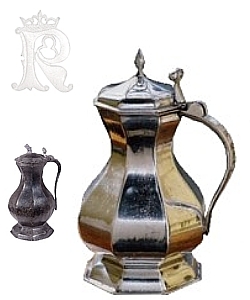 Hegagonal
Pewter Flagon Hegagonal
Pewter Flagon
Country of Origin: England, France, Switzerland
Time Period: 1350 onwards
Type of Item: Flagon
Colour: Silver
Materials: Pewter
Construction: 8 body panels soldered together. The
lid is cast in one piece with the finial and twin ball thumb-piece
being cast separately and then soldered on. 21cm tall. One
and a half pints capacity.
Decoration: Acorn finial on lid and hinge
Made by: Steve Millingham Pewter Reproductions or Lionheart
Replicas
Documentation: Artifact. Tonbridge Flagon, River Medway,
Tonbridge Castle, England. dated 1400. Three examples have
currently been found in England to date, while further examples
have been found on the continent.
|
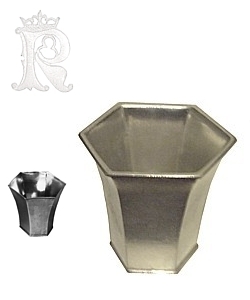 Hexagonal
pewter beaker Hexagonal
pewter beaker
Country of Origin: Prague
Time Period: 1350
Type of Item: Cup
Colour: Silver
Materials: Pewter
Construction: Pewter cast in one piece with hexagonal
sides.
Details of Decoration: None
Made by: Steve Millingham Pewter Reproductions
Documentation: Artifact, Prague. dated at between 1310
and 1335 and made of gilded silver and are from Prague. The
panels were made separately and soldered together. Other artifact
dated 1350 (?) Pewter tableware dates as early as the late
13th century. Approx 300 pieces are listed in Edward I's rolls.
|
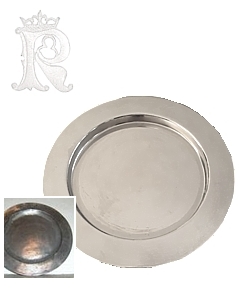 Large
silver plate Large
silver plate
Country of Origin: England
Time Period: medieval
Type of Item: Plate
Outer Colour: Silver
Construction Materials: Pewter
Details of Construction: Cast in one piece, wide flat
rim
Dimensions:
Details of Decoration: No decoration
Made by:
Documentation: Artifacts, Compton Castle Collection.
Pewter tableware dates as early as the late 13th century.
Approximately 300 pieces are listed in Edward I's rolls.
|
|
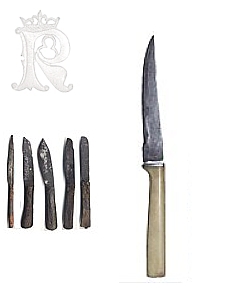 Bone
handled knife Bone
handled knife
Country of Origin:
England
Time Period: 1350-1400
Type of Item: Knife
Colour/colours: Cream
Materials: Bone, steel
Construction: Not known, original blade modified
Made by: unknown
Documentation: Artifact. 1350 Thames, England
|
|
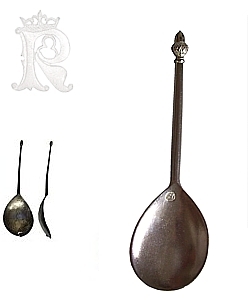 Acorn
knop spoon Acorn
knop spoon
Country of Origin: England France
Time Period: 14th century
Type of Item: Spoon
Colour: Silver
Materials: Pewter
Construction: Cast in one piece. Wide, fig-shaped
dish. Wide finial.
Decoration: Acorn finial, stamped S on bowl.
Made by: Steve Millingham Pewter Replicas
Documentation: Artifacts. York City Museum replica.
Also 14thC Bronze spoon, France, MedGallery, Collection
of Jean Boxhorn. Metropolitan Museum of Art states the first
known reference to the acorn spoon is in a will dated 1348
where John de Holegh bequeathed to Thomas Taillour "12
silver spoons with akernes". The Gilbert family lists
a purchase of 8 silver Acorn spoons.
|

Copyright
© Rosalie Gilbert
All text & photographs within this site are the property of
Rosalie Gilbert unless stated.
Art & artifact images remain the property of the owner.
Images and text may not be copied and used without permission.
|